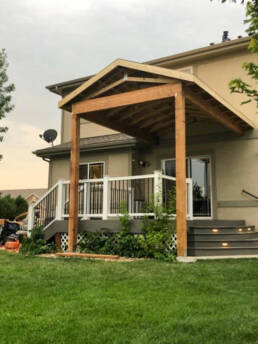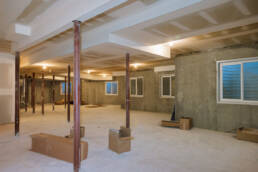In the mile-high city of Denver, where space is often at a premium, basement renovations present a unique opportunity for homeowners to expand their living areas and increase property value. However, transforming a basement from a dark, cluttered storage space into a functional and inviting area requires careful planning and strategic design. In this blog, we’ll explore expert tips and techniques for maximizing space in basement renovations tailored specifically for Denver homeowners.
Assessing Space Potential
When it comes to basement renovation in Denver, one of the most critical stages is assessing the space’s potential. Basements offer a wealth of possibilities, from additional living areas to entertainment spaces or even home offices. However, before diving into the renovation process, it’s essential for Denver homeowners to thoroughly evaluate their basement’s current state and envision its future transformation. In this guide, we’ll explore the key steps to effectively assess the potential of your Denver basement space.
Understanding Your Basement’s Layout
- Start by taking a comprehensive look at your basement’s layout. Note any existing walls, support beams, or utilities that may impact the renovation process.
- Consider the ceiling height and whether any structural modifications may be necessary to create a more open and inviting space.
- Evaluate any existing features such as windows, doors, or staircases and determine how they can be integrated into the renovation plan.
Identifying Potential Obstacles
- Assess any potential obstacles that may pose challenges during the renovation, such as low ceilings, uneven floors, or moisture issues.
- Look for signs of water damage or mold, which may indicate underlying issues that need to be addressed before proceeding with the renovation.
- Take note of any existing plumbing, electrical, or HVAC systems that may need to be rerouted or upgraded as part of the renovation process.
Determining Desired Functionality
- Consider how you envision using the renovated space. Are you looking to create a cozy family room, a home theater, or a functional home office?
- Think about the specific features and amenities you want to incorporate, such as a wet bar, built-in storage, or a dedicated workout area.
- Keep in mind the needs and preferences of your household members, as well as any future plans that may impact the design of the space.
By thoroughly assessing your Denver basement space, you can gain valuable insights that will inform the rest of the renovation process. Whether you’re aiming to maximize living space, increase property value, or enhance functionality, taking the time to understand your basement’s potential is the first step towards achieving your renovation goals.
Design Strategies for Space Optimization
Once you’ve assessed the potential of your Denver basement, the next step is to dive into design strategies that will optimize the space to its fullest potential. Maximizing space is essential, especially in basements where square footage may be limited. In this segment, we’ll explore effective design strategies tailored to Denver homeowners, ensuring that every inch of your basement serves a purpose and contributes to creating a functional and inviting living area.
Embrace Multi-Functional Furniture and Storage Solutions
- In a space-constrained environment like a basement, every piece of furniture should serve multiple purposes. Look for versatile options such as sleeper sofas, ottomans with hidden storage, or coffee tables that can double as desks.
- Incorporate built-in shelving and cabinetry to maximize vertical space and keep clutter at bay. Custom storage solutions can be tailored to fit the specific dimensions and layout of your basement, providing ample storage for belongings while maintaining a streamlined appearance.
Foster an Open-Concept Layout
- Create an open and airy feel by opting for an open-concept layout that eliminates unnecessary walls and barriers. This not only maximizes visual space but also encourages natural light to flow throughout the basement, making it feel brighter and more inviting.
- Consider using furniture placement and area rugs to define distinct zones within the open-concept layout, such as a seating area, entertainment zone, or workspace. This creates a sense of purpose for each area while maintaining the overall spaciousness of the basement.
Harness the Power of Vertical Space
- When floor space is limited, don’t overlook the potential of vertical space. Install floor-to-ceiling shelving units or wall-mounted storage systems to make the most of unused wall space while keeping essentials within easy reach.
- Opt for tall, narrow furniture pieces like bookcases or armoires that draw the eye upward and create the illusion of height, making the basement feel larger and more expansive.
Incorporate Smart Design Elements
- Explore innovative design solutions tailored to the unique challenges of basement living in Denver. For example, consider incorporating under-stair storage, fold-down desks, or murphy beds to maximize space efficiency without sacrificing style or functionality.
- Invest in smart home technologies that streamline daily routines and enhance the comfort and convenience of your basement living space. From automated lighting and climate control systems to voice-activated assistants, there are endless possibilities for integrating technology into your basement renovation.
By implementing these design strategies, you can transform your Denver basement into a versatile and efficient living space that meets the needs of your household while maximizing every square foot available. Stay tuned for more expert tips and insights as we continue our journey through the basement renovation process with Basements & Decks.
Lighting and Color Techniques
Lighting and color play pivotal roles in transforming the ambiance and functionality of any space, especially in basements where natural light may be limited. In Denver, where winters can be long and daylight hours short, strategic lighting and color techniques are essential for creating a bright, inviting, and visually spacious basement environment. In this guide, we’ll delve into expert tips and techniques to harness the power of light and color in your Denver basement renovation project.
Strategic Lighting Solutions
- Begin by assessing the existing lighting situation in your basement. Identify any dark corners or areas that lack adequate illumination.
- Incorporate a layered lighting scheme that combines ambient, task, and accent lighting to create depth and visual interest throughout the space.
- Install recessed LED ceiling lights to provide overall illumination while minimizing visual clutter and maximizing ceiling height.
- Supplement overhead lighting with strategically placed floor lamps, table lamps, and wall sconces to enhance functionality and ambiance in specific areas.
- Consider installing dimmer switches to control the intensity of light fixtures and create versatile lighting options for different activities and moods.
Choosing Light Colors for Walls and Flooring
- Opt for light, neutral colors for walls and flooring to maximize the perception of space and brightness in your basement.
- Shades of white, cream, beige, and light gray are excellent choices for walls as they reflect light and create a sense of airiness.
- Choose flooring materials in light tones such as light wood, laminate, or vinyl plank flooring to brighten up the space and create a cohesive look.
- Incorporate glossy or reflective finishes for walls and flooring to further enhance light reflection and amplify the brightness of the basement.
Incorporating Mirrors and Reflective Surfaces
- Strategically place mirrors on walls to bounce natural and artificial light around the room, creating the illusion of a larger and brighter space.
- Consider incorporating mirrored or glass furniture pieces, such as coffee tables or accent tables, to further enhance light reflection and add visual interest.
- Install mirrored backsplashes in wet bars or bathrooms to amplify light and create a sense of luxury and sophistication.
- Experiment with decorative accessories such as metallic accents, glass vases, or mirrored wall art to add sparkle and dimension to your basement decor.
By implementing these lighting and color techniques, you can transform your Denver basement into a luminous and inviting retreat that maximizes the available light and creates a welcoming ambiance year-round. Stay tuned for more expert insights and inspiration as we guide you through the exciting journey of basement renovation with Basements & Decks.
Functional Zones and Room Dividers
In Denver basement renovations, creating functional zones is crucial for maximizing space and ensuring that every area serves a specific purpose. However, without proper organization, a basement can quickly become cluttered and chaotic. That’s where room dividers come in – they offer a practical and stylish solution for delineating different zones while maintaining an open and cohesive layout. In this guide, we’ll explore innovative ways to design functional zones with room dividers in your Denver basement renovation project.
Assessing Your Basement’s Layout
- Begin by evaluating the layout of your basement and identifying areas where functional zones can be created.
- Consider factors such as traffic flow, natural light, and existing architectural features when planning the placement of room dividers.
- Determine the specific functions of each zone, whether it’s a lounge area, home office, gym, or entertainment space, to guide the design process.
Choosing the Right Room Dividers
- Select room dividers that complement the overall aesthetic of your basement and enhance its functionality.
- Opt for versatile options such as folding screens, sliding doors, or bookcase room dividers that can be easily adjusted to accommodate changing needs.
- Consider room dividers with built-in storage shelves or display units to maximize space efficiency and provide additional functionality.
Creating Distinct Zones
- Use room dividers to create distinct zones within your basement, such as a cozy seating area for relaxation, a dedicated workspace for productivity, or a designated play area for children.
- Experiment with different configurations and placements of room dividers to optimize space utilization and traffic flow.
- Incorporate elements of visual continuity, such as coordinating colors, materials, or decorative accents, to tie the various zones together and create a cohesive design scheme.
Maximizing Flexibility
- Design your basement with flexibility in mind, allowing for easy reconfiguration of functional zones as needs evolve over time.
- Choose lightweight and portable room dividers that can be moved or folded away to accommodate larger gatherings or special occasions.
- Explore creative solutions such as curtains, sheer drapes, or sliding panels as alternative room dividers that offer privacy without sacrificing openness.
Enhancing Aesthetic Appeal
- Treat room dividers as opportunities for enhancing the aesthetic appeal of your basement through thoughtful design and styling.
- Incorporate decorative elements such as artwork, plants, or accent lighting to personalize each zone and create visual interest.
- Consider using room dividers as focal points or design statements, integrating them seamlessly into the overall aesthetic of your basement renovation.
Flooring Options for Denver Basements
Selecting the right flooring for your Denver basement is a crucial decision that can significantly impact the overall look, feel, and functionality of the space. With Denver’s unique climate and potential moisture concerns, it’s essential to choose flooring materials that not only enhance the aesthetic appeal but also offer durability and resistance to water damage. In this guide, we’ll explore a variety of flooring options specifically suited for Denver basements, helping you make an informed decision that meets your design preferences and practical needs.
Durable and Moisture-Resistant Materials
- In Denver’s climate, where temperature fluctuations and occasional moisture are common, it’s important to choose flooring materials that can withstand these challenges.
- Consider options such as luxury vinyl plank (LVP), ceramic or porcelain tile, or concrete flooring, which are known for their durability and resistance to water damage.
- These materials are less susceptible to warping, swelling, or mold growth, making them ideal choices for basements where moisture levels may be higher than in other areas of the home.
Luxury Vinyl Plank (LVP)
- LVP flooring offers the look and feel of hardwood flooring with added benefits such as water resistance, durability, and ease of maintenance.
- Available in a wide range of styles, colors, and textures, LVP allows you to achieve the look of hardwood, stone, or tile flooring without the associated maintenance concerns.
- Its resilient construction makes it an excellent choice for high-traffic areas and spaces prone to moisture, such as basements, ensuring long-lasting beauty and performance.
Ceramic or Porcelain Tile
- Tile flooring is renowned for its durability, water resistance, and timeless aesthetic appeal, making it a popular choice for Denver basements.
- Choose ceramic or porcelain tiles with a low absorption rate and a slip-resistant surface for added safety and peace of mind.
- Explore a variety of sizes, shapes, and patterns to create custom designs and achieve the desired aesthetic for your basement space.
Concrete Flooring
- Concrete flooring offers a modern and industrial-chic look that is well-suited to contemporary basement designs.
- With proper sealing and finishing techniques, concrete floors can be made resistant to moisture, stains, and abrasion, making them an excellent choice for Denver basements.
- Enhance the visual appeal of concrete floors with decorative treatments such as staining, stamping, or scoring, allowing you to personalize the look and feel of your basement space.
Area Rugs and Carpet Tiles
- For added warmth, comfort, and acoustic insulation in your Denver basement, consider incorporating area rugs or carpet tiles over your existing flooring.
- Choose moisture-resistant carpet tiles that can be easily replaced or rearranged to accommodate changes in design or functionality.
- Opt for low-pile or synthetic fiber area rugs that are easy to clean and maintain, helping to protect your flooring investment and prolong its lifespan.
When it comes to flooring options for your Denver basement, durability, moisture resistance, and style are key considerations. By choosing materials such as luxury vinyl plank, ceramic or porcelain tile, concrete flooring, or incorporating area rugs and carpet tiles, you can create a beautiful and functional basement space that withstands the unique challenges of Denver’s climate. With careful selection and proper installation, your basement flooring can enhance the overall aesthetic appeal and value of your home for years to come. Basements & Decks.
Budgeting and Planning Tips
Embarking on a basement renovation project in Denver requires careful planning and budgeting to ensure that your vision becomes a reality within your financial constraints. From setting realistic expectations to prioritizing key investments, effective budgeting and planning are essential for a successful renovation outcome. In this guide, we’ll explore essential tips and strategies to help Denver homeowners navigate the budgeting and planning process, ensuring that their basement renovation project stays on track and delivers the desired results.
Setting Realistic Renovation Goals
- Begin by defining your renovation goals and priorities. What do you hope to achieve with your basement renovation, and what are your must-have features or improvements?
- Consider factors such as functionality, aesthetics, and resale value when setting your renovation goals, and be realistic about what can be accomplished within your budget and timeframe.
- Make a list of priorities and identify areas where you’re willing to compromise or make adjustments to stay within budget.
Establishing a Realistic Budget
- Determine your renovation budget based on your financial resources, available financing options, and the scope of work involved.
- Research the costs of materials, labor, permits, and other expenses associated with basement renovation projects in the Denver area.
- Set aside a contingency fund of 10-20% of your total budget to account for unexpected expenses or changes to the scope of work.
Prioritizing Key Investments
- Identify the areas of your basement renovation that are most important to you and prioritize your budget accordingly.
- Consider investing in high-impact features such as waterproofing, insulation, and HVAC upgrades, which can improve comfort, energy efficiency, and long-term durability.
- Allocate funds for quality materials and finishes that will enhance the overall aesthetic appeal and value of your basement space, such as flooring, cabinetry, and fixtures.
Obtaining Multiple Quotes
- Shop around and obtain quotes from multiple contractors and suppliers to ensure that you’re getting the best value for your money.
- Ask for detailed estimates that break down the cost of materials, labor, permits, and any additional fees or expenses.
- Consider factors such as reputation, experience, and references when selecting contractors and suppliers for your basement renovation project.
Planning for Phased Renovations
- If your budget is limited, consider breaking your basement renovation project into smaller, more manageable phases.
- Start with essential upgrades or improvements that address safety, structural integrity, and functionality, and plan to tackle cosmetic enhancements and additional features in future phases.
- Develop a long-term renovation plan that allows you to prioritize and budget for future phases based on your evolving needs and financial situation.
Tracking Expenses and Staying Organized
- Keep track of all expenses related to your basement renovation project, including receipts, invoices, and contracts.
- Use budgeting tools or software to monitor your spending and ensure that you’re staying within your allocated budget.
- Stay organized and maintain open communication with your contractors and suppliers throughout the renovation process to avoid cost overruns and delays.
Budgeting and planning are essential components of a successful Denver basement renovation project. By setting realistic goals, establishing a realistic budget, prioritizing key investments, obtaining multiple quotes, planning for phased renovations, and staying organized, you can ensure that your renovation project stays on track and delivers the desired results within your financial constraints. With careful planning and prudent decision-making, your basement renovation can transform your space into a functional, beautiful, and valuable asset for your home.
Conclusion
Budgeting and planning are integral aspects of any successful basement renovation project in Denver. By setting realistic goals, establishing a comprehensive budget, and adhering to a well-defined plan, you can navigate the renovation process smoothly and achieve the desired results within your financial constraints. Here, we’ve explored a range of budgeting and planning tips tailored to Denver homeowners, helping you make informed decisions and maximize the value of your investment.
Setting Realistic Goals
- Before embarking on your basement renovation journey, take the time to clarify your goals and priorities. Determine the primary functions of the renovated space and identify any must-have features or design elements.
- Consider factors such as your family’s lifestyle, future needs, and long-term plans for the basement to ensure that your renovation aligns with your vision and objectives.
Establishing a Comprehensive Budget
- Assess your financial resources and establish a realistic budget for your basement renovation project. Factor in all potential costs, including materials, labor, permits, and contingencies, to avoid any surprises down the line.
- Allocate funds strategically based on your priorities, focusing on essential elements such as structural repairs, insulation, and moisture control before allocating resources to cosmetic upgrades and furnishings.
Researching Cost-Effective Solutions
- Explore cost-effective alternatives and creative solutions to achieve your desired aesthetic and functionality without breaking the bank. Consider DIY options for tasks that you feel confident tackling yourself or sourcing materials from budget-friendly suppliers.
- Look for opportunities to repurpose existing materials or furnishings to minimize waste and reduce expenses. Upcycling old furniture or salvaging architectural elements can add character and charm to your basement renovation while saving money.
Obtaining Multiple Quotes
- Seek quotes from multiple contractors, suppliers, and service providers to ensure that you’re getting competitive pricing and value for your money. Compare estimates carefully, taking into account factors such as reputation, experience, and quality of workmanship.
- Don’t hesitate to negotiate pricing or request discounts or promotions, especially for larger projects or bundled services. Many contractors are willing to work with homeowners to accommodate their budget constraints and secure their business.
Allotting Contingency Funds
Set aside a contingency fund to cover unexpected expenses or unforeseen challenges that may arise during the renovation process. A general rule of thumb is to allocate 10-20% of your total budget for contingencies, providing a safety net for any unexpected costs.
By following these budgeting and planning tips, you can approach your Denver basement renovation project with confidence and peace of mind, knowing that you’ve taken proactive steps to manage costs and mitigate risks. Remember that while staying within budget is important, it’s equally crucial to prioritize quality, safety, and functionality to ensure a successful outcome that enhances the value and enjoyment of your home for years to come.
In conclusion, a well-executed basement renovation in Denver has the potential to transform your underutilized space into a valuable asset that adds comfort, functionality, and aesthetic appeal to your home. With careful budgeting, strategic planning, and prudent decision-making, you can achieve your renovation goals and create a basement that meets your needs and exceeds your expectations. Good luck on your renovation journey, and may your newly renovated basement bring you joy and satisfaction for many years to come! Contact us today.

Ready for an expert opinion? Get in touch today!
From concept to completion, entrust your project to skilled contractors who are dedicated to understanding your vision and executing it with precision. With their expertise and attention to detail, they’ll guide you through every step of the process, offering insights and solutions tailored to your needs and preferences.
Like this article? Spread the word!
Related Posts
November 21, 2024
Navigating Basement Waterproofing: Essential Tips for Denver Residents
Protect your Denver home with expert basement waterproofing tips from Basements & Decks R…
July 8, 2024
Basement Remodeling ROI: How Denver Homeowners Can Increase Property Value
Transform your Denver basement with Basements & Decks R Us. Custom designs, quality…
June 17, 2024
Denver Basement Renovation Trends for the Ultimate Entertainment Space
Transform your Denver basement into the ultimate entertainment space! This blog explores…




